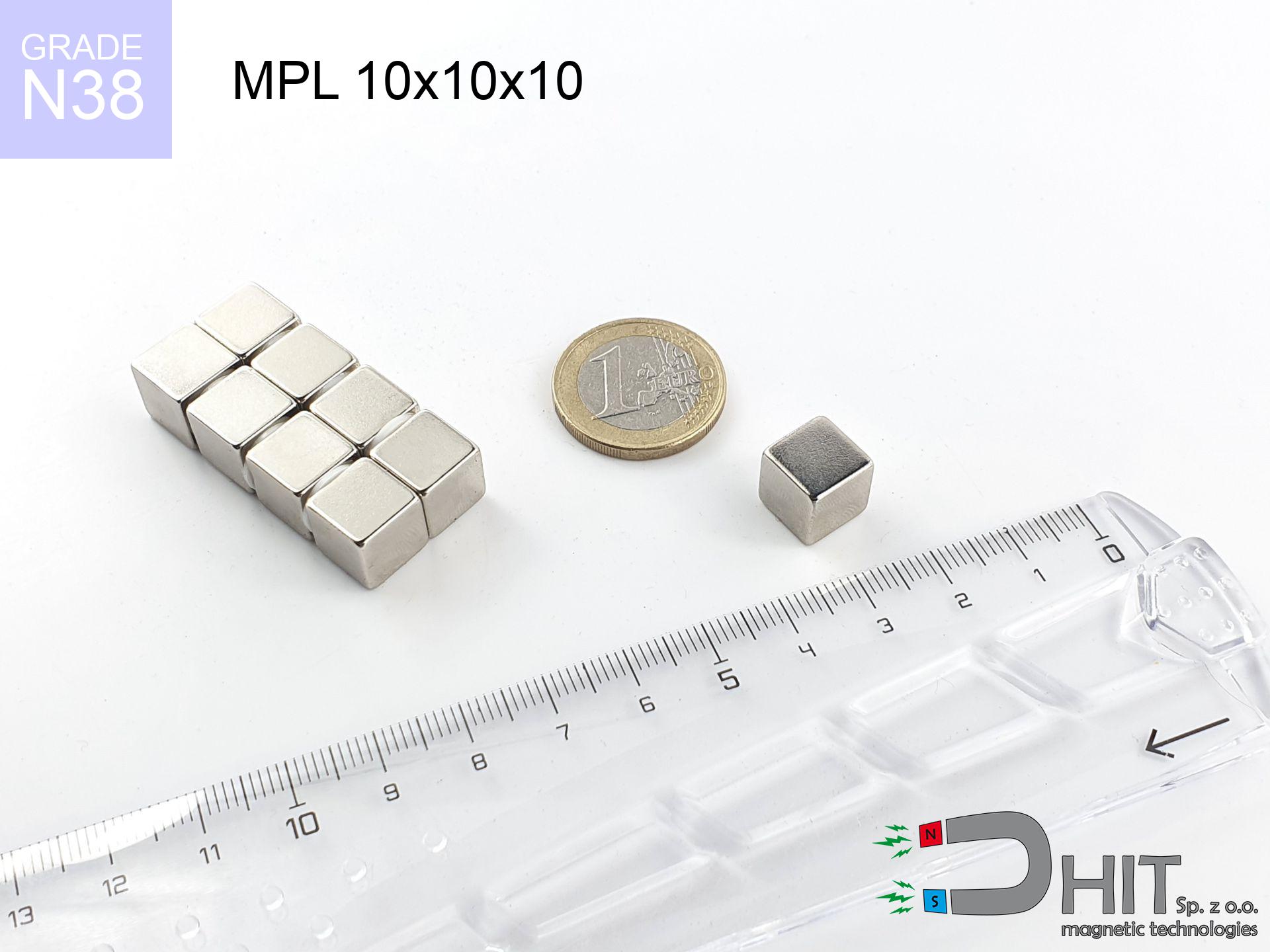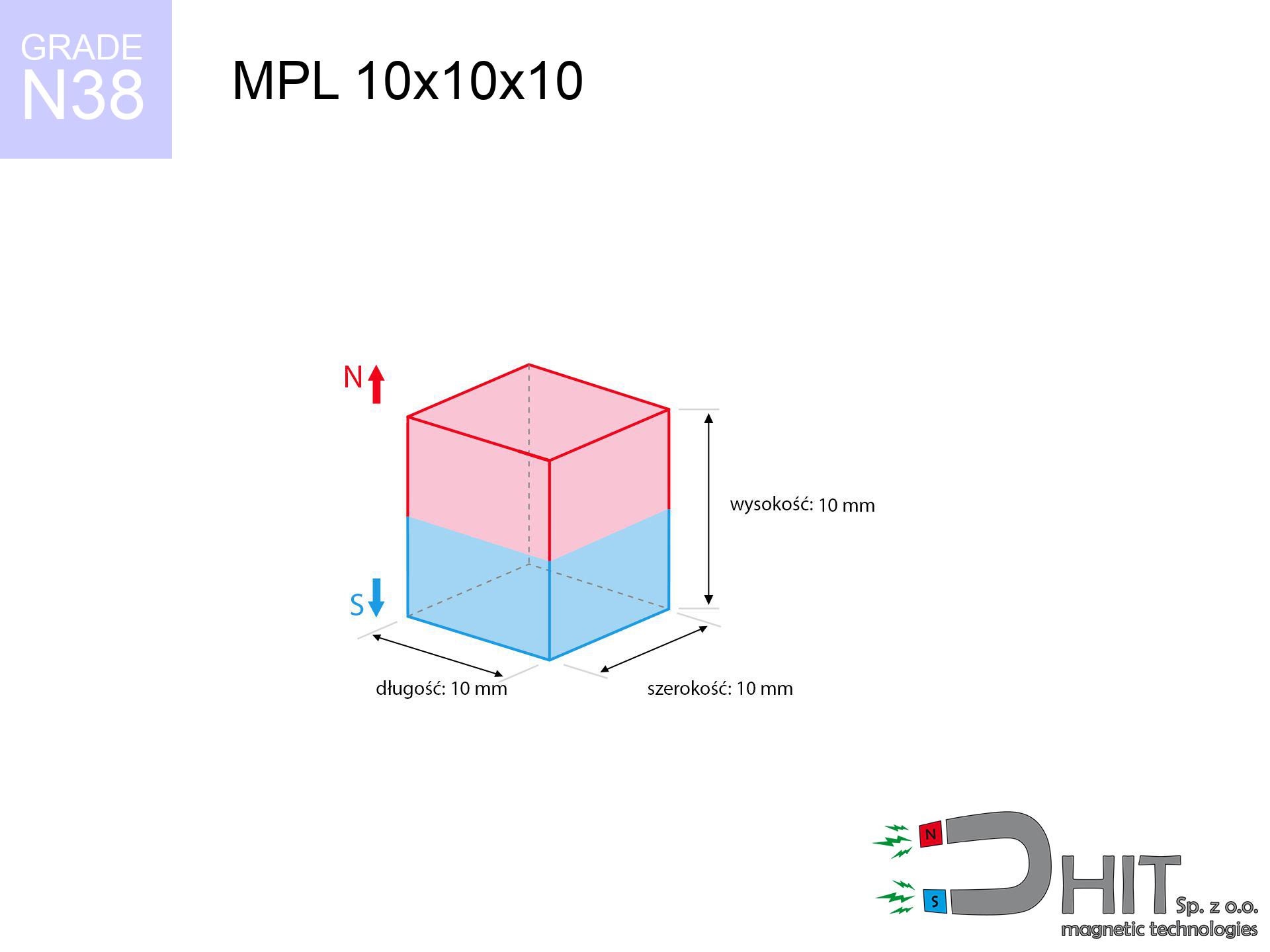MPL 10x10x10 / N38 - neodymium magnet
lamellar magnet
catalog number 020110
GTIN: 5906301811169
length
10 mm [±0,1 mm]
width
10 mm [±0,1 mm]
height
10 mm [±0,1 mm]
magnetizing direction
↑ axial
capacity ~
7.90 kg / 77.47 N
magnetic induction ~
539.91 mT / 5,399 Gs
max. temperature
≤ 80 °C
4.50 PLN gross price (including VAT) / pcs +
3.66 PLN net price + 23% VAT / pcs
bulk discounts:
need more quantity?Don't know what to choose?
Give us a call tel: +48 22 499 98 98 or write through contact form on the contact page. You can check the strength and the shape of neodymium magnets in our power calculator magnetic calculator
Orders placed by 2:00 PM will be shipped on the same business day.
Specification: lamellar magnet 10x10x10 / N38 ↑ axial
Magnetic properties of the material N38
Physical properties of sintered neodymium magnets Nd2Fe14B
Contact Surface: Due to their flat shape, disc magnets provide a significant contact surface with other elements, which is beneficial in applications requiring a stronger magnetic connection.
Applications in Technology: They are often utilized in various devices, like sensors, stepper motors, or speakers, where a flat shape is essential for their operation.
Mounting: This form's flat shape facilitates mounting, particularly when there's a need to adhere the magnet to another surface.
Design Flexibility: The flat shape of the magnets allows designers with greater flexibility in placing them in devices, which can be more difficult with magnets of more complex shapes.
Stability: In certain applications, the flat base of a disc magnet may provide better stability, reducing the risk of shifting or rotating. However, it's important to remember that the optimal shape of a magnet depends on the specific application and requirements. In certain cases, other shapes, such as cylindrical or spherical, may be a better choice.
Shopping tips
Advantages as well as disadvantages of neodymium magnets NdFeB.
In addition to immense power, neodymium magnets have the following advantages:
- They do not lose strength over time. After 10 years, their power decreases by only ~1% (theoretically),
- They are highly resistant to demagnetization by external magnetic field,
- In other words, thanks to the shiny coating of nickel, gold, or silver, the element acquires an aesthetic appearance,
- They have very high magnetic induction on the surface of the magnet,
- Magnetic neodymium magnets are characterized by very high magnetic induction on the surface of the magnet and can operate (depending on the shape) even at temperatures of 230°C or higher...
- Due to the option of accurate forming and adaptation to individual needs – neodymium magnets can be produced in many variants of shapes and sizes, which amplifies their universality in usage.
- Significant importance in the industry of new technologies – are used in hard drives, electric motors, medical apparatus and various technologically advanced devices.
Disadvantages of neodymium magnets:
- They are fragile when subjected to a powerful impact. If the magnets are exposed to impacts, we recommend using magnets in a protective case. The steel housing in the form of a holder protects the magnet from impacts and at the same time increases its overall strength,
- Magnets lose their power due to exposure to high temperatures. In most cases, when the temperature exceeds 80°C, these magnets experience permanent reduction in strength (although it is worth noting that this is dependent on the shape and size of the magnet). To avoid this problem, we offer special magnets marked with the [AH] symbol, which exhibit high temperature resistance. They can operate even at temperatures as high as 230°C or more,
- Due to their susceptibility to corrosion in a humid environment, we recommend using waterproof magnets made of rubber, plastic, or other moisture-resistant materials when using them outdoors,
- The use of a cover or a magnetic holder is recommended due to the limited possibilities of manufacturing threads or complex shapes in the magnet
- Potential hazard arising from small pieces of magnets pose a threat, when accidentally ingested, which is crucial in the context of children's health. It's also worth noting that tiny parts of these devices can be problematic in medical diagnosis when they are in the body.
Precautions
People with pacemakers are advised to avoid neodymium magnets.
In the case of neodymium magnets, there is a strong magnetic field. As a result, it interferes with the operation of a heart pacemaker. Even if the magnetic field does not affect the device, it can damage its components or deactivate the entire device.
Neodymium magnets are highly fragile, they easily crack and can become damaged.
Neodymium magnetic are fragile and will crack if allowed to collide with each other, even from a distance of a few centimeters. They are coated with a shiny nickel plating similar to steel, but they are not as hard. At the moment of connection between the magnets, small sharp metal fragments can be propelled in various directions at high speed. Eye protection is recommended.
Do not give neodymium magnets to youngest children.
Neodymium magnets are not toys. Be cautious and make sure no child plays with them. They can be a significant choking hazard. If multiple magnets are swallowed, they can attract to each other through the intestinal walls, causing severe injuries, and even death.
Neodymium magnets can attract to each other, pinch the skin, and cause significant swellings.
Magnets will attract each other within a distance of several to about 10 cm from each other. Remember not to place fingers between magnets or alternatively in their path when attract. Depending on how massive the neodymium magnets are, they can lead to a cut or alternatively a fracture.
Neodymium magnets are among the most powerful magnets on Earth. The astonishing force they generate between each other can shock you.
On our website, you can find information on how to use neodymium magnets. This will help you avoid injuries and prevent damage to the magnets.
Do not bring neodymium magnets close to GPS and smartphones.
Magnetic fields generated by neodymium magnets interfere with compasses and magnetometers used in navigation, as well as internal compasses of smartphones and GPS devices.
Dust and powder from neodymium magnets are flammable.
Avoid drilling or mechanical processing of neodymium magnets. If the magnet is crushed into fine powder or dust, it becomes highly flammable.
Keep neodymium magnets away from the wallet, computer, and TV.
Strong magnetic fields emitted by neodymium magnets can destroy magnetic storage media such as floppy disks, credit cards, magnetic ID cards, cassette tapes, video tapes, or other devices. In addition, they can damage televisions, VCRs, computer monitors, and CRT displays. You should especially avoid placing neodymium magnets near electronic devices.
The magnet coating contains nickel, so be cautious if you have a nickel allergy.
Studies show a small percentage of people have allergies to certain metals, including nickel. An allergic reaction often manifests as skin redness and rash. If you have a nickel allergy, try wearing gloves or avoid direct contact with nickel-plated neodymium magnets.
Neodymium magnets can become demagnetized at high temperatures.
Whilst Neodymium magnets can demagnetize at high temperatures, it's important to note that the extent of this effect can vary based on factors such as the magnet's material, shape, and intended application.
In order for you to know how powerful neodymium magnets are and why they are so dangerous, read the article - Dangerous powerful neodymium magnets.




![magnetic separator 32x300 [2xM8] / N52 magnetic separator 32x300 [2xM8] / N52](https://cdn3.dhit.pl/graphics/products/sm-32x300-2xm8-luf.jpg)

![magnetic beam 850x180x70 [4x M8] magnetic beam 850x180x70 [4x M8]](https://cdn3.dhit.pl/graphics/products/bm-850x180x70-4x-m8-mep.jpg)


